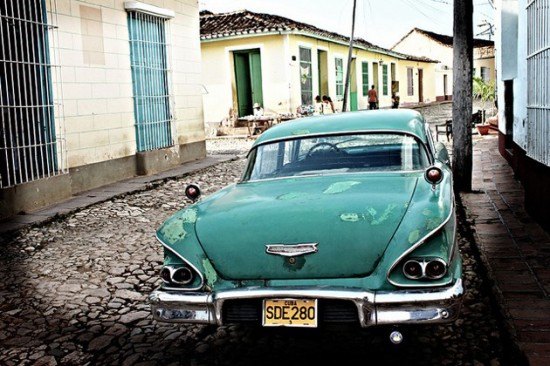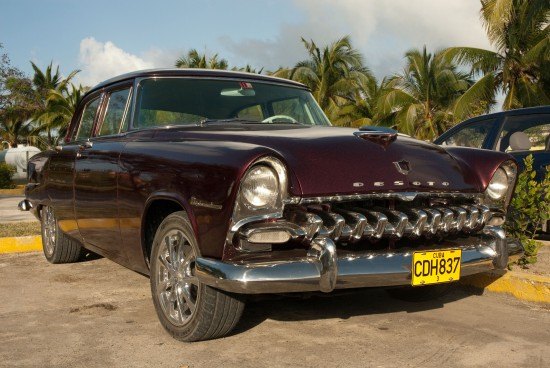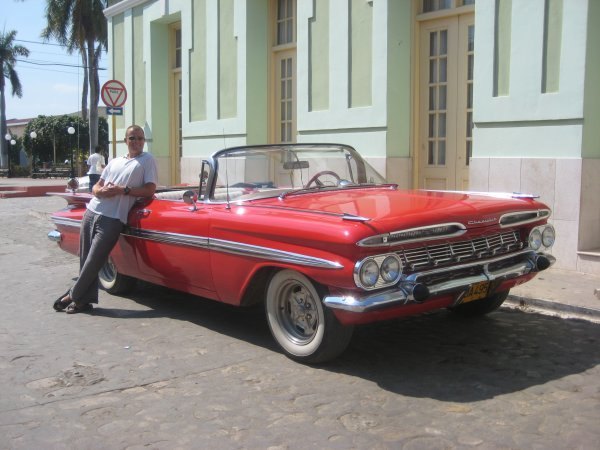#Cuba
You Still Can't Go To Cuba Just To See 'Yank Tanks'
If recent reports that you may soon be able to hop a flight from Miami to Havana, Cuba have you scrambling for your passport to spy Che’s Chevrolet and Fidel’s Oldsmobile, tranquilo.
According to Reuters, although commercial airlines in the U.S. may resume service to Cuba after a 54-year blackout, travelers to the island country still need to fall within 12 different criteria to enter the country, and “car watching” isn’t specifically one of them.
Journalists, humanitarians, doctors and people named Tom Morello still get to go.
Autoblog Tries, Fails To Rent Car in Cuba
Seyth Miersma of Autoblog has been exploring Cuba through a car enthusiast’s lens as of late, and it isn’t easy. In fact, the seasoned writer tried to rent a car in the island nation and ran into some cultural roadblocks.
CubaCar, Cuba’s state-run car rental service, may let you reserve a car at one of their many locations, but actually getting a car seems to be a bit of a headache. Also, it isn’t what you would call cheap or convenient.
Editorial: Cuba And The Axis Of Emerging Markets
A year ago, TTAC broke news of back channel overtures being made towards Iran on behalf of General Motors. A number of Chevrolet Camaro Convertibles made their way to Iran via a complicated logistics network and the importations were of dubious legality. But the event highlighted a sentiment in the auto industry that few are willing to openly discuss: the BRIC countries, once the darlings of the emerging markets, have already been exhausted. The search for new markets is on, and that means places like Africa and Iran. And Cuba could be next.
Cuban New-Car Sales Total 50 During First Half Of 2014
Last year, the Cuban government finally made it legal for its citizens to freely buy new vehicles for the first time since Fidel Castro sent Fulgencio Batista packing in 1959. The people rejoiced right up until they saw the prices on the showroom floor this January, family sedans marked up 400 percent or above as if they were Ferraris and Bugattis.
Congressman Tells Of His Ride Through Havana In A Russian-Powered 1954 Chevy
Rep. Ileana Ros-Lehtinen (R-FL) took to the House floor last night to speak on behalf of her recently-introduced resolution, House Resolution 488, a resolution “supporting the people of Venezuela as they protest peacefully for democratic change and calling to end the violence”.
Following her was Representative Steve King, a Republican from Iowa. In his monologue to democracy the congressman brought up a (legal) trip he took to Cuba where he got to ride in one of Cuba’s finest taxis – a 1954 Chevrolet powered by “a Russian diesel engine”, the driver of which who also happend to be a doctor. Such communism. Very Russian. Much oppressed. Below is a clip from his speech compliments of CSPAN’s awesome Create Clip Option.
Cubans Hoping to Buy New & Used Cars Despair As Government Stores Add 400% Dealer Markup
Last Friday, for the first time since the communist revolution there more than 50 years ago, Cubans were able to buy new and used cars without government permission, as state owned dealerships started retail sales, but residents of the island were disheartened by markups of 400% or more that the government is framing as a luxury tax. Cubans walked away from the Havana Peugeot dealer, a state-run enterprise, shaking their heads in disgust after seeing sticker prices ranging from the equivalent of $91,000 for a 2013 206 to $262,000 for a 508. For comparison, in the UK most 508s sell for less than $42,000. That’s quite a substantial additional dealer markup. Eighty percent of employed Cubans work for the state and the average wage in the country is about $20 a month so the cars area still out of reach to the vast majority of Cubans. The tens of thousands of small private businesses that have sprung up since the introduction of economic reforms have a great need for vehicles, but they too have been priced out of the market. At those prices, don’t expect Cuba’s fleet of old American iron to be taken out of service any time soon.
Maybelater's Trip To Cuba (Exclusive Pictures)
This Desoto has four wheel disc brakes and is the nicest Detroit iron I found...
(Some of the best stories in TTAC are told by the Best & Brightest, our readers. Many a TTAC career (mine included) started with a comment, then the odd story, and before you know it … Today’s story is from Ted Grant a.k.a. Maybelater. He sent in some pictures from a trip to Cuba. Maybelater is Canadian, he’s allowed to.
When asked for a few words, Ted said he’s not a writer. Then, he wrote the email that follows.
If you have a good story to tell, in words, pictures, or both, send it to me. It will be pro bono, but who knows, it could be the start of a glorious writing career. – BS)
I just returned from holidays in Cuba and snapped some shots of some vehicles in and around Santa Lucia. Most of the pre 1959 Detroit iron is heavily reworked and tired, but the fact that they are still in use is a testament to the original design engineers and the Cuban nationals’ ingenuity with limited resources. Our tour guide told us that even the ugliest POS vehicle that still runs commands big money and is a luxury for the locals. Some older cars have been handed down in families, but the majority of car owners have rich relatives in foreign countries that help them with the purchase. A typical 50’s Detroit ride runs 10 to 15 thousand so they are indeed a real luxury.
The Price Of Freedom: Cuban Classic Cars Endangered
Aren’t we all for freedom and democracy? Sure we are. But everything in moderation. And this is really getting too far: Cuba plans to lift a ban on the buying and selling of cars registered after the 1959 Revolution, Reuters reports.
Will Cuba's Reforms Mean An End To Its Unique Automotive Landscape?
Under current Cuban law, only cars built before the 1959 revolution can be legally bought and sold. This has kept Cuba’s pre-revolution American cars running, creating the island nation’s unique automotive landscape. But now, reports NPR, proposed liberalizations of Cuba’s property laws might threaten Cuba’s fleet of classic American cars. Though reforms could bring much-needed investment to Cuba, they would also mean an end to the laws that have kept Cuba’s streets looking like a time capsule from the late 1950s. But luckily Cubans have come to feel deeply attached to their classic American cars, vowing to keep them running as symbols of Cuba’s history.
As for Cuba’s classic cars, mechanic Jorge Prats says he thinks they’ll be around for at least another 50 years.
“These cars are a part of our national identity now, like rice and beans, or roast pork,” Prats says as he shows off his two-toned, bright red-and-white 1955 Chevrolet Bel Air coupe. “We take care of these old American cars as if they were another member of the family.”
The Cubafication Of America's Roads
The Ultimate Curbside Classic: 1956 Ford F-350 Still Hard At Work Six Days A Week
Welcome to Havana, Oregon. Back in the eighties, living in tony Los Gatos, I used to gaze longingly at photos of old American cars and trucks still hard at work in Cuba. But within days of moving to Eugene in 1993, I came across this very truck, hauling its daily cargo of recycled cardboard. And it planted a seed in me, to document the old vehicles still earning their keep, which finally came to fruition with Curbside Classics. Although we’ve strayed from the strict interpretation of that mission a few times along the way, no other vehicle more perfectly embodies the original ethos than this 1956 F-350.
























Recent Comments